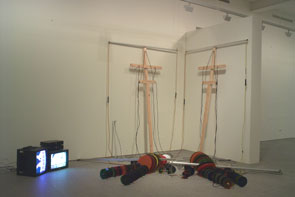 |
|
|
 |
|
Case study summary (2007)
creator(s) Arianne Vanrell (conservator)
contributor(s) MNCARS, Madrid
publisher MNCARS, Madrid
The installation occupies a corner in a space of about 5 metres by 4 metres depending on the space available in each location, and is made up of various materials including two puppets made of methacrylate pieces, metal cords, plastic balls, metal tubes, pieces of wood, rubber cords, two TV monitors and two DVD players showing the puppets in action. It was installed with the help of the artist, as this was the first time it had been exhibited at the MNCARS.
The piece presents a play between the present and the past and the transmission of energy through actions. With Circle puppets, the puppets are the testimony to past actions.
Focus
1. To establish the right way to exhibit this work.
2. To establish the point of view of the artist on the conservation of his artworks.
3. To define the meaning of each element in the idea that must be transmitted
4. To learn the best way of documentation to reinstall the work.
Artist Interview
For Oppenheim the support was not an important factor in the identity of the work and he considered the TV monitors and DVD players as tools, the originals of which do not have to be preserved.
The video elements were composed of two VHS videos which had been converted to DVDs because the images were of better quality and it was easier to show his work on them.
Circle puppets comprises different elements of different materials; there are a number of smaller pieces that form a whole and each piece has its own significance as a unique element. Oppenheim likes the idea of the substitution of some elements, as long as the substitution is only the response to the natural ageing process of some materials.
To effect these substitutions appropriately, it is necessary to know perfectly each piece of the whole and the whole itself. To that end, there is no doubt of the importance of a good registration and documentation programme, updated regularly to increase its effectiveness.
Several subjective aspects are difficult to measure and evaluate. Among these variables, we can point out the control of sound, brightness, or more intangible issues like different exhibition spaces.
The opportunity to work with Oppenheim in the mounting of all the installations in our collection gave us the best information possible to achieve a well-arranged project.
During the process of mounting we could obtain a lot of information and understand many aspects of the process of creation. Also it was interesting to see how he reacted to specific questions about the conservation of his works and their meaning, and how his ideas about conservation had changed over time.
This is where documentation shows its real importance, not only as a registration exercise but as a tool for further reinstallations.
During the installation process we learnt more and in greater depth about his work, his philosophy of life, and the evolution of his work from Land Art to Installations. Working with Oppenheim, we realized the importance of the meaning vs. the aesthetic issues.
Documenting and visualizing
Each installation has its own considerations, problems and solutions, so the important thing is to have a good management system and a good working protocol. We have to prioritise the information that we will actually need and learn how to describe it more specifically.
We have to recover all the essential information without spending too much time on documentation that may not be useful or easy to consult.
At the end of the process…
as we became more involved in his philosophy and in his work, Dennis Oppenheim was more concerned about conservation than he was at the beginning of the installation project.
During the Case Studies we focused our points of view, and learned to identify our goals, making it easier to determine the importance of each part of an installation and the right and simple way of transmitting the message.
 Copyright Protected Copyright Protected
|